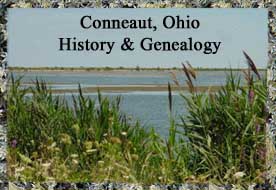 |
INDIAN BURIAL GROUND in CONNEAUT, OHIO |
 |
INDIAN BURIAL GROUND in CONNEAUT, OHIO |
|
Found at Conneaut Public Library, Conneaut, Ohio The following article was found in PREHISTORIC RACE It was near the mouth of Conneaut Creek, a stream not then navigable, but now one of the deepest and most important harbors on the south shore of Lake Erie, that Moses Cleveland and his party of surveyors first touched Ohio, in their journey to this section for purpose of making a survey of the Western Reserve, the new possession of the Connecticut Land Company, of Connecticut. While this party was given credit for being the first company of white persons to establish themselves in the county, developments of later years disclosed indisputable evidence that at some time in the far-gone centuries this section had been inhabited by a race of people of gigantic stature who were not Indians. Delving into great mounds of earth that were not of natural formation brought forth bones of this prehistoric people, as well as pottery, crude weapons and other belongings that had been buried with the dead. Yet, with all this evidence, there has never yet been found a manuscript or writing of any nature that would give the slightest hint as to the personality of those early residents. Where they came from, how long they were here, or where they eventually departed for is a mystery that will probably never be solved. The first intimation of these people was uncovered in and about where is now the city of Conneaut, and as the settlements became more numerous and extensive many other sections of the county reported similar finds, indicating that this vicinity was well populated. Conneaut, however, seemed to have been the metropolis of these people, as indicated by a large burying ground on the bank of the river west of the originally settled town, and another in the sugar-loaf like prominence across the river to the south. A writer says "When first discovered the spot was covered with trees not distinguishable from the surrounding forest, except an opening near the center containing a single butternut. The graves were distinguished by slight depressions in the surface of the earth, disposed in straight rows, which, with intervening spaces, or valleys, covered the entire area. The number of these graves has been estimated to be between two and three thousands. The ancient burying-grounds occupy an area of about four acres and appear to have been accurately surveyed into lots running from north to south and when first seen presented the appearances of neat and orderly arrangement." Aaron Wright, Esq., in 1800, made a careful examination of these depressions and found them invariably to contain human bones blackened with time, which, upon exposure to the air, soon crumbled to dust. Some of these bones were of unusual size and evidently belonged to a race allied with giants. Skulls were taken from these mounds, the cavities of which were of sufficient capacity to admit the head of an ordinary man, and jaw-bones that might be fitted over the face with equal facility. The bones of the upper and lower extremities were of corresponding size.
|
|
CLICK HERE to RETURN to |